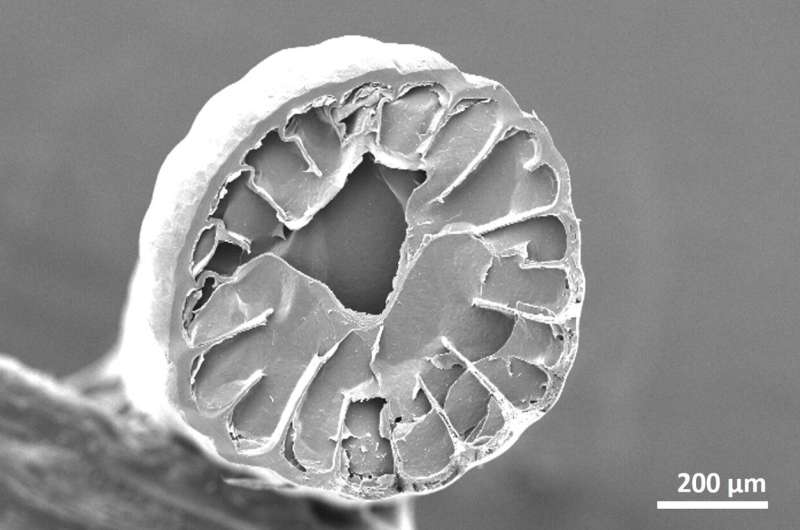
Detailed microscale images of the inside of a hedgehog spine have revealed that the internal structure looks similar to the inside of a citrus fruit, which may explain their strength and flexibility.
To celebrate Hedgehog Awareness Week run by the British Hedgehog Preservation Society from 30thApril to 6th May, a team at the University of Nottingham’s Nanoscale and Microscale Research Centre (nmRC) have investigated hedgehog spines using a range of materials characterization techniques including X-Ray Photoelectron Spectroscopy (XPS) and Scanning Electron Microscopy (SEM).
Microscale images were created of the interior and exterior of the spines. One of the most surprising results came from imaging of the cross section of the spine which revealed support segments and hollow sections, similar to when a citrus fruit is cut in half. The images also showed that the exterior had a ribbed surface texture and scaly microstructure.
nmRC collaborated with local charity Hedgepigs on this project to raise awareness about hedgehogs by showing the public the inside of a hedgehog spine—something they have probably never have seen before. Dr. Hannah Constantin, XPS technician at the nmRC is a huge fan of hedgehogs and signed the University of Nottingham up to become a Hedgehog Friendly Campus, she imaged the spines alongside electron microscope technician Lorelei Robertson.
Hannah says, “I have very fond memories of watching hedgehogs in my parents’ garden when I was a child, they were frequent visitors. As an adult, I started seeing them less and less, and after doing some research, I found out that hedgehog numbers in the UK have declined by 50% since the year 2000. Resolved to do something about it, I discovered the Hedgehog Friendly Campus initiative, and signed the University of Nottingham up. Slowly the group grew, and we now have silver Hedgehog Friendly Campus status and are currently working towards gold.”
“It’s great that the nmRC is helping to raise awareness about hedgehogs and I was keen to be involved. Getting people talking about hedgehogs is a great starting point to help our spiky friends. We have used XPS and SEM to study the elemental composition and structure of hedgehog spines. This is important because it will give conservationists vital information to continue their amazing work.”
Although the project didn’t analyze the reasons behind the internal structure of the spines, Hedgehog enthusiast Hannah suggests: “I would say that the fins allow for a good strength-to weight ratio of the spine. A hollow spine would be light, but easy to bend or crush. A completely solid spine would be strong but heavy. The fins resist bending and crushing, but don’t add a lot of weight, and their radial arrangement probably strengthens them in (almost) all directions.”
The hedgehog spines were kindly donated by Deborah Korn from local hedgehog rescue charity Hedgepigs. The results have been collated and a short e-booklet and two posters have been produced as educational resources.
Deborah Korn, founder of hedgehog rescue charity Hedgepigs commented: “Hedgehog Awareness Week is massively important to highlight the plight of one of our nation’s favorite wildlife species. Hedgehogs have been around since the days of the saber tooth tiger. But they are now under immense pressure as a species.”
“They are currently on the UK’s Red List, which means they are vulnerable to the point of extinction. We humans are their main problem in their fight to survive, but we can also be the reason that they succeed and keep going for millennia to come. It is vital that we do everything we can to understand them if we are able to help their species survive. This Hedgehog Awareness Week, we are incredibly proud to have been able to help the University of Nottingham take a look at hedgehog spines in a new way using incredible imaging techniques.”
Provided by
University of Nottingham

READ MORE
How the First Surviving Quintuplets Became a Tourist Attraction
National Film Board of Canada/Library and Archives Canada (PA-155518) On May 28, 1934, a miracle [...]
Visual observation of photonic Floquet–Bloch oscillations
Photonic implementation and generalized acceleration theory. a Schematic of a one-dimensional lattice composed of evanescently [...]
Machine Gun Kelly Makes Fan’s Dream Come True With Punch In The Face
While most performers request their fans to refrain from physical violence, punk-rocker Machine Gun Kelly [...]
Researchers fabricate arrays of atomically smooth iron-coated silicon pyramids with unusual magnetic properties
(a) Wide and (b) magnified images of the fabricated Si pyramids. Four slopes correspond to [...]
How to Get Your Daikon Radish On
Daikon may not look like the radishes we’re used to seeing, but it’s a great [...]
Rhino Horn and Tiger Wine: How the Illegal Wildlife Trade Is Growing Bolder
A record 105 tons of ivory was burned in Kenya in 2016, destroying tens of [...]
Mapping How the Brain Thinks
The challenge is to figure out how all that wiring works. Image courtesy of Human [...]
New nanoparticles deliver therapy throughout the brain and edit Alzheimer’s gene in mice
Researchers at UW-Madison have engineered silicone nanoparticles to cross the blood-brain barrier in mice to [...]